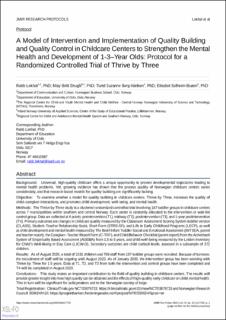A model of intervention and implementation of quality building and quality control in childcare centers to strengthen the mental health and development of 1-3-year olds: Protocol for a randomized controlled trial of thrive by three
Journal article, Peer reviewed
Published version

Åpne
Permanent lenke
https://hdl.handle.net/11250/2998526Utgivelsesdato
2020Metadata
Vis full innførselSamlinger
- Scientific articles [2181]
Sammendrag
Background:
Universal, high-quality childcare offers a unique opportunity to prevent developmental trajectories leading to mental health problems. Yet, growing evidence has shown that the process quality of Norwegian childcare centers varies considerably, and that research-based models for quality building are significantly lacking.
Objective:
To examine whether a model for quality building in childcare centers, Thrive by Three, increases the quality of child–caregiver interactions, and promotes child development, well-being, and mental health.
Methods:
The Thrive by Three study is a clustered randomized controlled trial involving 187 toddler groups in childcare centers across 7 municipalities within southern and central Norway. Each center is randomly allocated to the intervention or wait-list control group. Data are collected at 4 points: preintervention (T1), midway (T2), postintervention (T3), and 1-year postintervention (T4). Primary outcomes are changes in childcare quality measured by the Classroom Assessment Scoring System toddler version (CLASS), Student–Teacher Relationship Scale, Short Form (STRS-SF), and Life in Early Childhood Programs (LECP), as well as child development and mental health measured by The Brief Infant Toddler Social and Emotional Assessment (BITSEA, parent and teacher report), the Caregiver–Teacher Report Form (C-TRF), and Child Behavior Checklist (parent report) from the Achenbach System of Empirically Based Assessment (ASEBA) from 1.5 to 5 years, and child well-being measured by the Leiden Inventory for Child’s Well-Being in Day Care (LICW-D). Secondary outcomes are child cortisol levels, assessed in a subsample of 372 children.
Results:
As of August 2020, a total of 1531 children and 769 staff from 187 toddler groups were recruited. Because of turnover, the recruitment of staff will be ongoing until August 2020. As of January 2020, the intervention group has been working with Thrive by Three for 1.5 years. Data at T1, T2, and T3 from both the intervention and control groups have been completed and T4 will be completed in August 2020.
Conclusions:
This study makes an important contribution to the field of quality building in childcare centers. The results will provide greater insight into how high quality can be obtained and the effects of high-quality early childcare on child mental health. This in turn will be significant for policymakers and to the Norwegian society at large.
Trial Registration:
ClinicalTrials.gov NCT03879733; https://clinicaltrials.gov/ct2/show/NCT03879733 and Norwegian Research Council 260624/H10; https://prosjektbanken.forskningsradet.no/#/project/NFR/260624/Sprak=en
International Registered Report Identifier (IRRID):
DERR1-10.2196/17726
JMIR Res Protoc 2020;9(10):e17726
doi:10.2196/17726